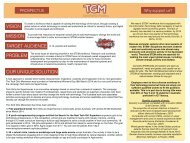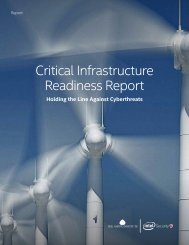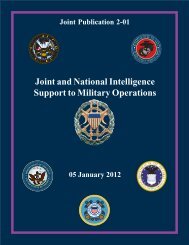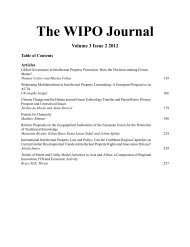Transparency Initiative (EITI)
2eoch1l
2eoch1l
Create successful ePaper yourself
Turn your PDF publications into a flip-book with our unique Google optimized e-Paper software.
92 Recommendations<br />
When <strong>EITI</strong> stakeholders make decisions, regarding the direction<br />
and steps to take with the <strong>Initiative</strong>, quite a complex<br />
and dynamic set of issues needs to be considered. The<br />
following recommendations aim at preparing the <strong>EITI</strong> to<br />
monitor and evaluate results while accounting for the very<br />
real financial and staffing constraints that exist for the <strong>EITI</strong><br />
internationally and nationally.<br />
STRATEGY<br />
1. Focus on measurability of outcomes and impact of the<br />
<strong>EITI</strong> (Requirement 7): Without a timely introduction of<br />
M&E, categories of effectiveness and impact cannot be<br />
adequately assessed in the future. The regular monitoring<br />
instruments of the work plan, annual report, annual<br />
activity report and Validation report were found to primarily<br />
provide an overview of the activities undertaken<br />
to ensure compliance with <strong>EITI</strong> Requirements and<br />
achieving the (largely <strong>EITI</strong> process-related) objectives.<br />
As put in an evaluation report five years ago weaknesses<br />
remain in the form of “little impact at the societal level”<br />
and “lack of links with larger public sector reform”<br />
(Scanteam 2011).<br />
Much has been done since 2011 to tackle those<br />
problems, not least the introduction of the 2013<br />
Standard. Validation is a check of countries’ compliance<br />
to the <strong>EITI</strong> Standard, and not an evaluation of impacts –<br />
unless the latter is consistently fostered as part of the<br />
Standard. If the ambitious level of Requirement 7 is<br />
upheld, reporting will need to focus on results that are<br />
higher in the hierarchy of a results model. These are<br />
outcomes and impacts. They can be identified with<br />
a casespecific theory of change. The generic results<br />
model of this study can be used for improving results<br />
measurement and highlighting the value of the <strong>EITI</strong><br />
as an instrument for evidence-based reform processes<br />
that, if applied, can help the <strong>EITI</strong> to be successful in<br />
the long-term. However, measuring outcomes and<br />
impacts requires expertise beyond the capacity to<br />
understand the fiscal and technical aspects of <strong>EITI</strong><br />
Reports, and the Validation process does not have<br />
standardized methodologies that ensure this will<br />
happen. For example, there is no provision to assess<br />
stakeholder views outside of MSGs, apply benchmarks<br />
like international indices, and no guidance on how to<br />
qualitatively determine if there has been public debate<br />
and anti-corruption measures or just some report<br />
launch events and ads in the newspaper.<br />
In between the generic results model (global) and country-specific<br />
results models (in this study for DR Congo<br />
and Mozambique) it can be helpful to develop the following<br />
category-specific results models for better analytical<br />
results:<br />
I. Level of development: Categories based on the IMF’s<br />
World Economic Outlook (WEO), advanced economies<br />
(in Table B of the WEO 2016), and emerging market and<br />
developing economies (in Tables D and E of the WEO<br />
2016), furthermore heavily indebted poor countries<br />
(HIPCs), and low-income developing countries (LIDCs).<br />
II. Level of resource-endowment: Categories based on EI<br />
share of GDP, EI revenue share of budget, EI share of exports<br />
according to IMF and World Bank data.<br />
III. Level of good governance: Categories based on<br />
democratic/autocratic systems according to BTI.<br />
IV. Analytical level for results logic: global/international,<br />
national, local.<br />
2. Measure the perception of impact: The <strong>Initiative</strong> needs<br />
to deliver primarily in contexts of weak governance.<br />
Those contexts are often characterized by a lack of statistical<br />
data and weak monitoring and evaluation capacities.<br />
Use of systems in implementing countries<br />
and mainstreaming monitoring of the <strong>EITI</strong> is desirable.<br />
However, in the original group of <strong>EITI</strong> countries<br />
(Sub-Saharan Africa and Central Asia) the statistical and<br />
monitoring capacities are weak. Furthermore, it will<br />
take a long time until the impact of the 2013 Standard<br />
can be evaluated based on macro data.<br />
Given that approximately USD 50 million is spent globally<br />
every year to support <strong>EITI</strong> reporting, it may be justified<br />
to apply an <strong>EITI</strong> related benchmarking system to<br />
measure status and progress, until the day when it will<br />
be possible that the impact of implementation of the<br />
2013 Standard can be monitored in data of third parties<br />
(e.g. World Bank, HDI, BTI). The approach of the online<br />
survey of this study (Annex III) could be adapted for this<br />
purpose. If so, the adaptation should consider making<br />
the results more reliable compared to this study, e.g. to<br />
establish a panel of resource persons that can be interviewed<br />
frequently (annually or biannually) over longer









